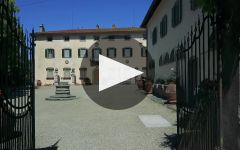Capezzana Carmignano Villa di Trefiano Riserva 2015

Product Details
Your Rating
Somm Note
Winemaker Notes






Few wineries in the world possess the stature, respect and devotion that the Contini Bonacossi family has cultivated and maintained over five generations with their Tenuta di Capezzana winery. The estate is located 12 miles west of Florence in the Carmignano sub-zone, one of the oldest recognized wine producing areas in Tuscany. Ancient Etruscan artifacts have shown that grapevines were cultivated in the area for wine production over 3,000 years ago. The first reference to Capezzana dates to 804 A.D. An ancient parchment stored at the Florentine state archives shows the granting of a lease of vineyards and olive groves for the cultivation of wine and olive oil to a place called Capezzana.
Over the centuries, the estate passed through several families. But the story of today’s Capezzana started when the Count Alessandro Contini Bonacossi and his family returned to Italy after living in Spain and purchased the estate from Raimondo Franchetti’s widow, Sara de Rothschild, in 1920. Not content with this original holding, Count Alessandro acquired the two neighboring farms, “The Poggetto” and “Trefiano,” dividing the property into three distinct estates with more than 120 poderi. The winery was dedicated to the production of high-quality wine and olive oil with the first vintage of Villa di Capezzana in 1925.
Augusto, Alessandro’s son, took over the management of the estate and in 1945, his son, Ugo, joined him. Ugo had completed a degree in Agriculture before heading to the War, and he was devoted to increasing the quality of the family’s wines – a notable endeavor during a time when most producers were still selling their grapes by weight. It was Ugo’s vision that gradually moved the estate away from sharecropping towards a modern-day winery.
Carmignano was first incorporated into the Chianti Montalbano appellation; however, with a unique microclimate, soil composition and the use of international grapes, the Carmignano wines were very different than the Chianti being produced by their neighbors. Due to the tireless efforts of Count Ugo,DOC status was finally granted to Carmignano in 1975. In 1988 the appellation finally received DOCG recognition, making it the smallest DOCG in Tuscany.
In order to qualify as a Carmignano DOCG wine, the blend needs to include a small amount of Cabernet Sauvignon (10-20%). In the 1500s, the Queen of France, Catherine de Medici, had clippings of Cabernet Sauvignon - then known as "uve Francesca" - sent to Carmignano from Bordeaux. Much of those plantings disappeared with the phylloxera epidemic, but Cabernet was replanted by Count Ugo in the1950s. When Carmignano received DOC status in 1975, it became the first sanctioned wine to include Cabernet Sauvignon in Tuscany.
The winery today is comprised of a Renaissance-era villa with historic cellars dating to the sixteenth century, a Frantoio for olive oil production, a Vinsantaia where the estate's legendary Vin Santo is produced, and a fermentation cellar built in 1938 by architect Giovanni Michelucci. The estate's landholdings expand 670 hectares 80ha of vineyards and 140ha of olive groves.
In 2009, Capezzana began farming organically and achieved official certification for the vineyards and wines in 2015. Today,the estate is in the hands of Beatrice, Benedetta and Filippo Contini Bonacossi, fourth generation, and Serena and Gaddo Contini Bonacossi, fifth generation. Together they oversee all aspects of a family business that continues to maintain the stature, respect, and devotion that has been cultivated for centuries.

With hundreds of red grape varieties to choose from, winemakers have the freedom to create a virtually endless assortment of blended red wines. In many European regions, strict laws are in place determining the set of varieties that may be used, but in the New World, experimentation is permitted and encouraged resulting in a wide variety of red wine styles. Blending can be utilized to enhance balance or create complexity, lending different layers of flavors and aromas. For example, a red wine blend variety that creates a fruity and full-bodied wine would do well combined with one that is naturally high in acidity and tannins. Sometimes small amounts of a particular variety are added to boost color or aromatics. Blending can take place before or after fermentation, with the latter, more popular option giving more control to the winemaker over the final qualities of the wine.
How to Serve Red Wine
A common piece of advice is to serve red wine at “room temperature,” but this suggestion is imprecise. After all, room temperature in January is likely to be quite different than in August, even considering the possible effect of central heating and air conditioning systems. The proper temperature to aim for is 55° F to 60° F for lighter-bodied reds and 60° F to 65° F for fuller-bodied wines.
How Long Does Red Wine Last?
Once opened and re-corked, a bottle stored in a cool, dark environment (like your fridge) will stay fresh and nicely drinkable for a day or two. There are products available that can extend that period by a couple of days. As for unopened bottles, optimal storage means keeping them on their sides in a moderately humid environment at about 57° F. Red wines stored in this manner will stay good – and possibly improve – for anywhere from one year to multiple decades. Assessing how long to hold on to a bottle is a complicated science. If you are planning long-term storage of your reds, seek the advice of a wine professional.

With recorded history of red wine production since the Middle Ages, Carmignano is a small, ancient, central Italian subregion ten miles northwest of Florence. Carmignano grows Sangiovese with great success in low-lying hills of 160 to 650 feet above sea level.
It is the only Tuscan DOC that required the inclusion of (up to 20%) Cabernet Sauvignon in its Sangiovese-based wines years before it became popular in the Super Tuscan blends.
